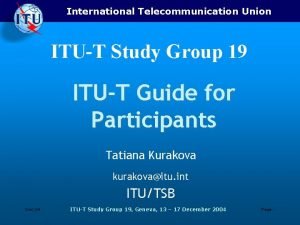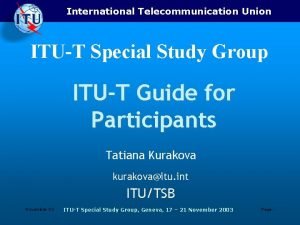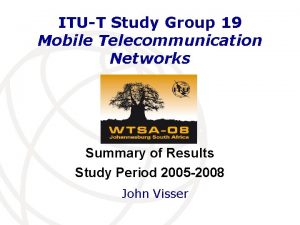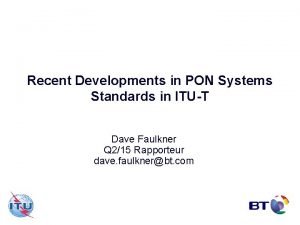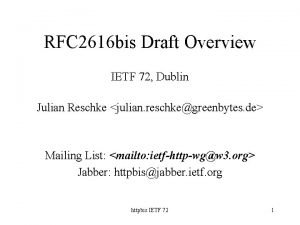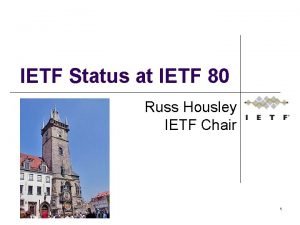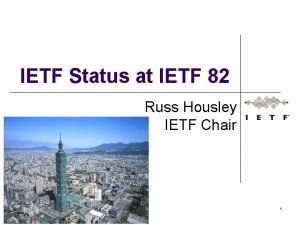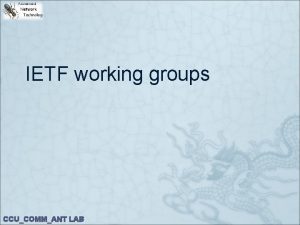Total Conversation through ITUT IETF Standards Sign Type








- Slides: 8

Total Conversation through ITU-T & IETF Standards: Sign, Type, and Speak – You Decide Paul E. Jones Cisco Systems, Inc. May 7, 2004 © 2004 Cisco Systems, Inc. All rights reserved.

It’s All About “Total Conversation” • The ITU-T and IETF are working on standards that bring about the convergence of • Voice telephony • Video telephony • Text telephony • These standards aim to enable what it calls “Total Conversation” © 2004 Cisco Systems, Inc. All rights reserved. 2

Defining the Multimedia Service • The ITU-T defined a series of service specifications and included text and video as components of the multimedia services (F. 700 and F. 703) • Several multimedia protocols evolved, including: • H. 323 – Multimedia communication over packet-switched networks (ITU-T) • SIP – Session Initiation Protocol (IETF) • H. 320 - Multimedia communication over ISDN (ITU-T) • H. 324 – Multimedia communication over low bit-rate links (phone lines and mobile phones) (ITU-T, 3 GPP) • Multimedia systems largely focused only on voice and video © 2004 Cisco Systems, Inc. All rights reserved. 3

Standards focused on Disabilities • H Series Supplement 1 – Raised awareness about sign language and lip reading as it relates to video quality • Standards to allow text conversation: • ITU-T T. 140 defines a representation of text suitable for transmission over IP networks and able to support all languages in the world • IETF RFC 2793 defines how to transport T. 140 over IP • H. 323 and SIP can utilize RFC 2793 to transmit text © 2004 Cisco Systems, Inc. All rights reserved. 4

To. IP Objectives (“Text over IP”) • Focused on bridging two PSTN networks via IP • Allow for character-by-character text communication • Allow for simultaneous two-way conversation, along with voice and video (inherent limitations of the PSTN an obstacle) • Standardize on an international character set (Unicode) • Support all standard TTY device types defined in ITU-T V. 18 • Enable different device types to communicate through each other by using the gateways as “interworking” devices (see next slide) • Enable legacy, PSTN devices to communicate with newer, IPbased systems To. IP Site: http: //www. packetizer. com/iptel/toip/ © 2004 Cisco Systems, Inc. All rights reserved. 5

RFC-2793 Enables Global TTY Communications )) Cellphone w/ SMS ) ( (( IP Network PC Instant Msg PSTN – V. 21 United Kingdom V. 21 TTY Device IP End Point Phones / Voicemail / IVR Gateway SMS / IM to RFC 2793 PC IP Softphone PSTN -Ba RFC-2793 PSTN Gateway udot U. S. Baudot TTY Device • Today, TTY devices are islands and cannot communicate with other text devices or other TTY protocol around the world • A new standard enables global TTY communications (e. g. V. 21 to Baudot) • RFC-2793 enables transport of real-time text over Vo. IP • V. 151 defines how to use RFC 2793 between PSTN gateways, allowing interconnection of dissimilar TTY types (expected ratification late 2004 / early 2005) • RFC-2793 enables text communication revolution • Integration with IP End Points (e. g. IP Phones, Voicemail, Softphone, etc. ) • Integration with Instant Messaging (70 M users) • Integration with wireless Short Messaging Systems (75 M US users – IDC 2003, 1. 3 B world-wide users – Radicati) © 2004 Cisco Systems, Inc. All rights reserved. 6

Ultimate Goal – Total Conversation • To allow any device to support the transmission of video and/or text signals • To allow a user on a PC connected to an IP network to chat with a user on a legacy PSTN TTY device • To improve communications with the widespread adoption of video • To allow a user with a wireless PDA to communicate with anybody in the world • To not require special tools for communications © 2004 Cisco Systems, Inc. All rights reserved. 7

Conclusion Enable Video, Text, and Voice Communications. So you can Sign, Type, or Speak. You Decide. © 2004 Cisco Systems, Inc. All rights reserved. 8

